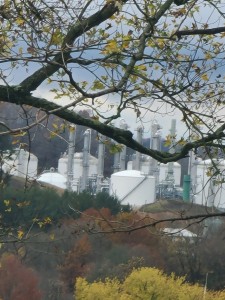
Frack gas wells require pipeline networks, compressor stations and gas processing & extraction plants (see above)
Essay by Randi Podladnik, Environmental Scientist, Tappan Lake, OH, Nov. 10, 2023
Many hunters are entering wooded areas in Ohio in search of deer, turkey, and pheasants. One of the most popular places to hunt are Ohio’s public lands, especially parks and wildlife areas in the Southeastern portion of the state.
Among the top ten counties for deer harvests in the 2022-23 season were: Coshocton (7,590), Tuscarawas (7,028), Muskingum (5,982), Guernsey (5,073), and Carroll (4,251). The Ohio Department of Natural Resources reported that “hunters from all 50 U.S. states purchased deer permits in Ohio for use in the 2022-23 seasons with Pennsylvania hunters topping the list, buying 9,365 permits and West Virginia hunters purchasing 4,400 permits.”
The hunting community adds significant amounts of money to Ohio’s economy each year, spending nearly $866 million on food, equipment, lodging, fuel, and other merchandise. A report by the Sportsmen’s Alliance Foundation estimates that close to half a million hunters participate in recreational hunting each year in Ohio, which translates to “15,500 jobs, $68 million in state and local taxes, and $753 million of the state’s GDP.”
Why would Ohio’s Oil and Gas Land Management Commission want to jeopardize an activity that provides so much revenue for the state, and enjoyment for Ohio residents and out of state residents? Why would this commission even consider fracking excellent hunting areas like Guernsey County’s Salt Fork State Park or Carroll County’s Valley Run Wildlife Area?
These areas located above Marcellus and Utica shale deposits provide habitat for hundreds of species of mammals, birds, fish, reptiles, and amphibians. The most obvious effects of gas extraction are fragmentation and loss of habitat. Fracking requires the complete clearing of land for well pads, infrastructure, pipelines, and roads.
This means acres of forested lands are lost as they become asphalted over, clear-cut, or covered in gravel. In order to restore areas to the original forests, they must be regraded, topsoil needs to be added, and native species should be replanted. But this type of reclamation is expensive and not regulated, and often the only reclamation that is done is reseeding areas with non-native grass species.
Forest fragmentation from endless pipelines and access roads leads to the introduction of invasive species, the disruption of predator-prey relationships, drops in migratory bird species, and a reduction of core-forest habitat. We also know that fracking fluid and waste releases can be toxic to fish and wildlife, as noted by the spill that occurred in 2007 at Acorn Fork Creek in Kentucky which killed numerous fish species including the “protected” blackside dace. Additionally, surface waters, including local streams, are impacted by water withdraws that lower water volume, create temperature increases, change pH, and amplify water pollutants.
A hunter described hunting this way: “it offers an understanding and appreciation of wildlife and their ecosystems like no other outdoor activity. Hunting affords the exploration of wild places, and provides delicious, nutritious protein for a meal at a time where much of our food is processed or modified.”
How will hunters feel about hunting at Salt Fork State Park when fracking brings light pollution, noise pollution, water pollution, and air pollution to a place that was once wild? Tell the commission to deny the leases for Ohio Parks. Their email is commission.clerk@oglmc.ohio.gov or attend the Oil and Gas Land Management Commission Meeting on November 15th at 10 am with a press conference at 9:30 at the ODNR 2045 Morse Rd, in Columbus, Ohio.
